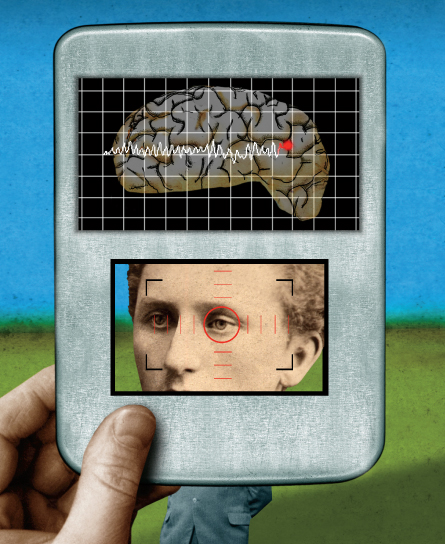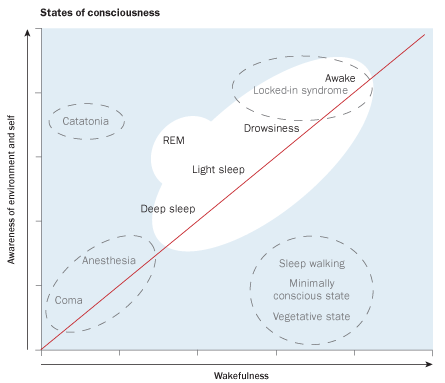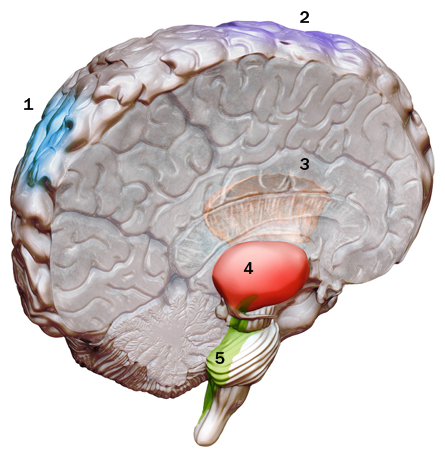Emblems of Awareness
Brain signatures lead scientists to the seat of consciousness
- More than 2 years ago
This article is part of Demystifying the Mind, a special report on the new science of consciousness. The next installments will appear in the February 25 and March 10 issues of Science News.



Humankind’s sharpest minds have figured out some of nature’s deepest secrets. Why the sun shines. How humans evolved from single-celled life. Why an apple falls to the ground. Humans have conceived and built giant telescopes that glimpse galaxies billions of light-years away and microscopes that illuminate the contours of a single atom. Yet the peculiar quality that enabled such flashes of scientific insight and grand achievements remains a mystery: consciousness.
Though in some ways deeply familiar, consciousness is at the same time foreign to those in its possession. Deciphering the cryptic machinations of the brain — and how they create a mind — poses one of the last great challenges facing the scientific world.
For a long time, the very question was considered to be in poor taste, acceptable for philosophical musing but outside the bounds of real science. Whispers of the C-word were met with scorn in polite scientific society.
Toward the end of the last century, though, sentiment shifted as some respectable scientists began saying the C-word out loud. Initially these discussions were tantalizing but hazy: Like kids parroting a dirty word without knowing what it means, scientists speculated on what consciousness is without any real data. After a while, though, researchers developed ways to turn their instruments inward to study the very thing that was doing the studying.
Today consciousness research has become a passion for many scientists, and not just for the thrill of saying a naughty word. A flood of data is sweeping brain scientists far beyond their intuitions, for the first time enabling meaningful evidence-based discussions about the nature of consciousness.
“You’re not condemned to walk around in this epistemological fog where it’s all just sort of philosophy and speculation,” says neuroscientist Christof Koch of Caltech and the Allen Institute for Brain Science in Seattle. “It used to be the case, but now we can attack this question experimentally, using the tools of good old science to try to come to grips with it.”
Knowledge emerging from all of this work has ushered researchers into a rich cycle of progress. New experimental results have guided theoretical concepts of consciousness, which themselves churn out predictions that can be tested with more refined experiments. Ultimately, these new insights could answer questions such as whether animals, or the Internet, or the next-generation iPhone could ever possess consciousness.
Though a detailed definition remains elusive, in simplest terms, consciousness is what you lose when you fall into a deep sleep at night and what you gain when you wake up in the morning. A brain that is fully awake and constructing experiences is said to be fully conscious. By comparing such brains with others that are in altered states of awareness, researchers are identifying some of the key ingredients that a conscious brain requires.
In the hunt for these ingredients, “we decided to go for big changes in consciousness,” says Giulio Tononi of the University of Wisconsin–Madison. He and others are studying brains that are deeply asleep, under anesthesia or even in comas, searching for dimmer switches that dial global levels of consciousness up or down.
Scrutinizing brain changes that correspond to such levels has led some scientists to a central hub deep in the brain. Called the thalamus, this structure is responsible for constantly sending and receiving a torrent of neural missives. Other clues to consciousness come from a particular kind of electrical signal that the brain produces when it becomes aware of something in the outside world. But rather than one kind of signature, or one strategic brain structure, consciousness depends on many regions and signals working in concert. The key may be in the exquisitely complicated ebb and flow of the brain’s trillions of connections.
Hub of activity
A profoundly damaged thalamus turned out to be at the center of one of the first right-to-die battles in the United States. A heart attack in 1975 left 21-year-old Karen Ann Quinlan in a nonresponsive, unconscious vegetative state for a decade. After she ultimately died of natural causes, an autopsy revealed surprising news: Quinlan’s cerebral cortex, the outer layer of the brain where thoughts are formed, appeared relatively unscathed. But the thalamus was destroyed.
The thalamus is made up of two robin’s egg–sized structures that perch atop the brain stem, a perfect position to serve as the brain’s busiest busybody. It is the first stop for many of the stimuli that come into the brain from the eyes, ears, tongue and skin. Like a switchboard operator, after gathering information from particular senses, the thalamus shoots the signals along specific nerve fibers, connecting the right signal to the right part of the brain’s wrinkly cortex.
These strong connections, along with evidence from vegetative state patients, make the thalamus a prime suspect in the hunt for the seat of consciousness. A 2010 study in the Journal of Neurotrauma, for example, found atrophy of the thalamus in people in a vegetative state.
Not only is the thalamus itself compromised, but also its connections — white-matter tracts that carry nerve signals — seem to be dysfunctional in people who aren’t fully conscious, researchers reported last year in NeuroImage.
“I can’t help but think there’s something fundamental about the functional circuitry,” says neuroscientist David Edelman of the Neurosciences Institute in San Diego. “There’s a fundamental loop between … the thalamus and the cortex. If those connections are cut or if you’ve damaged them, that individual will not be aware by any measure, forever.”
One of the most startling pieces of evidence implicating the thalamus came from a patient who had existed in a minimally conscious state for six years, drifting in and out of awareness. After surgery in which doctors implanted electrodes that stimulated his thalamus, the man began responding more consistently to commands, moved his muscles and even spoke.
But the part the thalamus plays in consciousness is not straightforward. Its role may be as complex as the intricate spidery connections linking it to the rest of the brain.
“The thalamus has two souls,” says Martin Monti, a neuroscientist at the University of California, Los Angeles. One of the souls receives information directly from the outside world, and one receives information from other parts of the brain. “It turns out that there are many more connections going from cortex back to thalamus,” he says. “There’s a lot of chitchat.”
This huge influx of messages from the cortex may mean that the thalamus is simply a very sensitive readout of cortical behavior, as work reported in 2007 in Anesthesiology hints.
As anesthesia took hold of participants in the study, activity in the cortex wavered, yet the thalamus kept chugging away normally for about 10 minutes. If the thalamus were the ultimate arbiter of consciousness, its behavior should have changed before that of the cortex.
Instead of being a driver, the thalamus may be a consciousness gauge. In the same way that a thermometer can tell you to grab a coat but doesn’t actually make it cold, the thalamus may tell you a person is conscious without making it so.
Reading waves
Rather than studying the thalamus, some researchers focus on long-range brain waves that ripple over the cortex. One such ripple, a fast electrical signal called a gamma wave, has garnered a lot of attention. These waves, which in some cases emanate from the thalamus, are generated by the combined electrical activity of coalitions of nerve cells behaving similarly. Gamma waves spread over the brain at about 40 waves per second; other brain waves — such as those thought to mark extreme concentration or attention — are slower.
Gamma waves have been spotted along with mental processes such as memory, attention, hearing noises and seeing objects. And studies have even found that the waves are present in REM sleep, the stage marked by intense dreams.
Such associations have led some researchers to propose that gamma waves bind disparate pieces of a scene, tying together the rumble of a boat’s outboard, the crisp breeze and a memory of a black lab into a unified lake experience.
But some new data call gamma waves’ role in consciousness into question, by finding that the signal can be present when consciousness is not. Researchers, including Tononi, monitored electrical signals in brains of people as anesthesia took hold. When eight healthy people were anesthetized with propofol (the powerful anesthetic that Michael Jackson used to sleep), gamma waves actually increased, the team reported last year in Sleep. Consciousness was clearly diminished, yet the gamma waves persisted.
Specific brain signals, such as gamma waves, might be important aspects of consciousness, but not the main driving forces in the brain. “I can put gamma waves into any machine,” says Tononi. But doing so won’t give the machine a conscious mind.
The same may be true for structures such as the thalamus, as well as other regions that have been scrutinized by scientists, including the parietal and frontal cortices, the reticular activating system in the brain stem and a thin sheetlike structure called the claustrum.
Increasingly nuanced views of the ingredients at work in a conscious brain have led some scientists to a new suspicion: Perhaps the thing in the brain that underlies consciousness is not a thing at all, but a process. Messages constantly zing around the brain in complex patterns, as if trillions of tiny balls were simultaneously dropped into a pinball machine, each with a prescribed, mission-critical path. This constant flow of information might be what creates consciousness — and interruptions might destroy it.
Crucial connections
One way to look for signs of interrupted information flow is by conducting brain scans as propofol takes effect. In a study published last July in NeuroImage, 18 healthy volunteers were administered the anesthetic while in a functional MRI brain scanner. fMRI approximates a brain region’s activity by measuring blood flow: The busier the brain region, the more blood flows there.
While deeply anesthetized, some brain regions that normally operate in tandem fell out of sync, Jessica Schrouff of the University of Liège in Belgium and colleagues reported. Conversations within particular brain areas, and also between far-flung brain areas, fell apart.
People in vegetative states also appear to have interruptions in brain connections, Mélanie Boly of the University of Liège and colleagues found after comparing these patients with healthy volunteers. Participants listened to a series of tones, most of which were similar, but every so often, a strange “oddball” tone would play, spurring a big reaction in the brain. The initial brain reaction in vegetative state patients was normal, as measured by EEG monitors.
The signal seemed to travel from the auditory regions of the brain to other areas in the cortex. But the signal stopped there. Unlike in healthy people, the pinball-like motion of information traveling from different sites in the cortex didn’t make its way back down to the auditory regions that first responded to the tone, the team reported last May in Science.
It’s not clear just what causes these disconnects. One possible culprit, as counterintuitive as it seems, may be an overload of synchrony, Gernot Supp of the University Medical Center Hamburg-Eppendorf in Germany and colleagues reported in December in Current Biology. As an anesthetic kicks in, huge swaths of the brain adopt slow, uniform behavior. This hypersynchrony, as it’s called, may be one way that anesthesia stamps out the back-and-forth of information in the brain.
Instead of just observing the brain’s behavior and inferring connectivity, Tononi, Marcello Massimini of the University of Milan in Italy and colleagues decided to manipulate the brain directly. The team figured out how to use a technique called transcranial magnetic stimulation, or TMS, to jolt a small part of the brain and monitor the resulting signals with electrodes.
“Basically you trigger a chain of reactions in the cerebral cortex,” Massimini says. “It’s like we’re knocking on the brain with this pulse, and then we see how this knocking propagates.”
Like ripples on a pond, the reverberation from the TMS in a healthy, alert person was a complex, widely spreading pattern lasting about 300 milliseconds.
This complex entity became much simpler, though, when the brain was deeply asleep. Instead of morphing from one shape to another like a drop of food coloring that roils around in water before dissipating, the signal sits right where it started, and it fades faster, disappearing after about 150 milliseconds. The same simple pattern is found in anesthetized brains.
“If you knock on a wooden table or a bucket full of nothing, you get different noises,” Massimini says. “If you knock on the brain that is healthy and conscious, you get a very complex noise.”
Massimini, Tononi and colleagues have recently found the same stunted response in patients in a vegetative state. The team tested five vegetative state patients, five minimally conscious patients and two people who were fully conscious but unable to move (a condition called locked-in syndrome). For the most part, locked-in patients and minimally conscious patients showed complex and long-lasting signals in the brain, similar to fully conscious people. But vegetative state patients’ brains showed a brief, stagnant signal, the team reported online in January in Brain.
Such clear-cut differences in the brain could one day help in diagnosing people who have some level of consciousness but are unable to interact with doctors. When researchers performed the test on five new patients who shifted to a vegetative state in the months after coming out of a coma, three of the five regained consciousness. Before the doctors saw clinical signs of improvement, the method picked up increases in brain connectivity.
At this stage, the measurement is somewhat coarse, Massimini says. But further refinements may allow doctors to better assess levels of consciousness.
Looking at these large-scale changes in the brain may also provide some new leads to scientists puzzling over what consciousness means. Other ideas will probably come from scientists studying a different facet of consciousness: how the brain builds whole experiences out of many small pieces, such as the crisp taste of an apple, the rustle of fall leaves and a feeling of joy.
Approaching consciousness from a lot of different angles is the best bet for ultimately understanding it, says neuroscientist Anil Seth of the Sackler Centre for Consciousness Science in Brighton, England.
In the same way that “life” evades a single, clear definition (growth, reproduction or a healthy metabolism could all apply), consciousness might turn out to be a collection of remarkable phenomena, Seth says. “If we can explain different aspects of consciousness, then my hope is that it will start to seem slightly less mysterious that there is consciousness at all in the universe.”
Read Tom Siegfried’s essay on consciousness, “Self as Symbol.”
Recipe for consciousness
Somehow a sense of self emerges from the many interactions of nerve cells and neurotransmitters in the brain — but a single source behind the phenomenon remains elusive.
 Nicolle Rager Fuller
Nicolle Rager Fuller
1. Parietal cortex Brain activity in the parietal cortex is diminished by anesthetics, when people fall into a deep sleep and in people in a vegetative state or coma. There is some evidence suggesting that the parietal cortex is where first-person perspective is generated.
2. Frontal cortex Some researchers argue that parts of the frontal cortex (along with connections to the parietal cortex) are required for consciousness. But other scientists point to a few studies in which people with damaged frontal areas retain consciousness.
3. Claustrum An enigmatic, thin sheet of neural tissue called the claustrum has connections with many other regions. Though the structure has been largely ignored by modern scientists, Francis Crick became keenly interested in the claustrum’s role in consciousness just before his death in 2004.
4. Thalamus As one of the brain’s busiest hubs of activity, the thalamus is believed by many to have an important role in consciousness. Damage to even a small spot in the thalamus can lead to consciousness disorders.
5. Reticular activating system Damage to a particular group of nerve cell clusters, called the reticular activating system and found in the brain stem, can render a person comatose.






